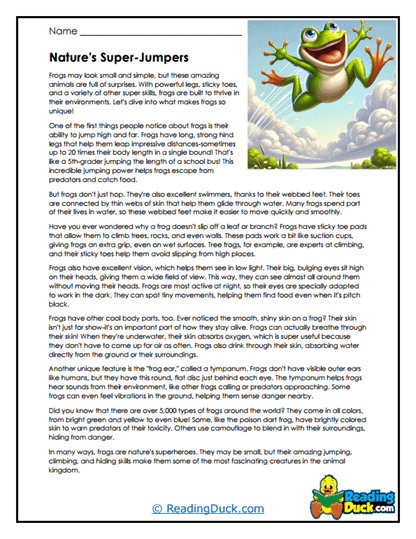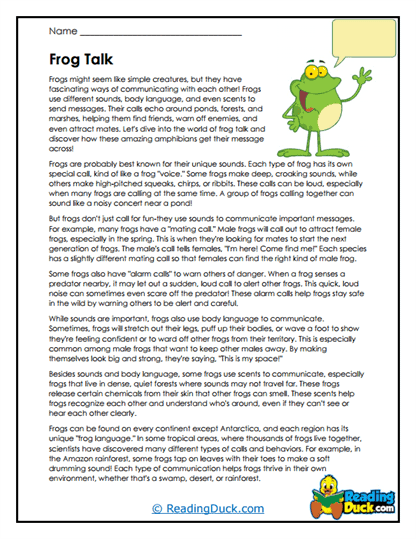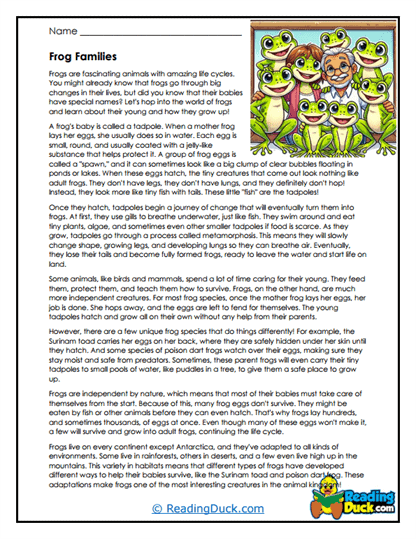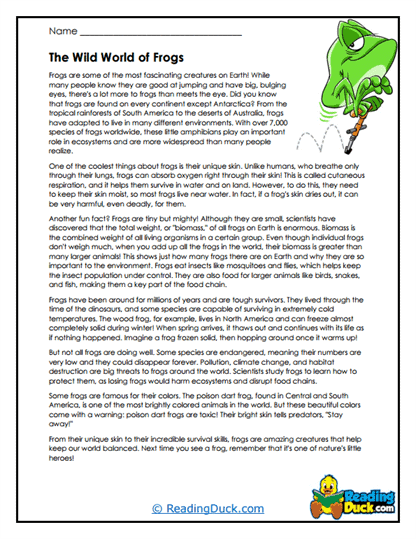Frogs Worksheets
About Our Frog Worksheets
Our frog worksheets will help students learn about frogs in a fun way. They are perfect for both individual and group learning, and teachers can use them in science classes to support lessons about amphibians, habitats, life cycles, and ecosystems. Frog worksheets can vary in difficulty, making them suitable for different grade levels and ages.
Types of Worksheets
1. Exploring Resting Habits
The "Frogs at Rest" worksheet introduces students to the unique ways frogs rest and recover. Unlike humans and other animals that sleep in long stretches, frogs often rest in short periods throughout the day and night. This worksheet helps students understand how different factors like habitats and threats influence frogs' resting behaviors. By examining how frogs adapt their resting habits to stay safe and conserve energy, students can connect this behavior to the animal's survival needs in the wild.
2. Discovering Sizes and Shapes
In the "Frogs Big and Small" worksheet, students explore the amazing variety in frog sizes across different species. From tiny frogs as small as a fingernail to the enormous Goliath frog, which can be over a foot long, students learn about how size impacts where frogs live and how they survive. This worksheet might include fun facts and visual comparisons, helping students picture how frogs' sizes vary based on their environments and the unique adaptations each size offers.
3. Understanding Transformation
The "Fantastic Frogs" worksheet delves into the fascinating life cycle of frogs, emphasizing metamorphosis, the transformation that frogs undergo from tadpoles to adult frogs. Students learn how frogs start as aquatic creatures with gills and tails, then grow legs and develop lungs as they prepare for life on land. This worksheet covers the stages of this transformation, teaching students about the concept of adaptation and why it is crucial for frogs' survival across different habitats.
4. Learning About Defenses
In the "Frog Defenses" worksheet, students examine the various ways frogs protect themselves from predators. Camouflage, bright warning colors, and toxins are all ways frogs have evolved to stay safe in the wild. The worksheet includes examples like the brightly colored poison dart frog, which warns predators of its toxicity, and camouflaged frogs that blend into their environments. Through these activities, students gain insight into the survival strategies frogs use to avoid danger.
5. Exploring Frog Family Structures
"Frog Families" introduces students to the way frogs reproduce and care for their young, often with fascinating behaviors unique to each species. This worksheet highlights the difference between frogs that lay eggs in water and those that provide some level of parental care. Students learn about frog egg clutches and the journey from egg to tadpole to adult frog. By learning about frog families, students understand the importance of each life stage and how frogs ensure the survival of their species.
6. Discovering Frog Diets and Hunting Skills
The "Frog Feasts" worksheet focuses on the diets of frogs, teaching students that frogs are carnivores and eat a variety of insects, spiders, and even small fish. This worksheet covers how frogs use their sticky tongues to catch prey and their role in controlling insect populations. Students may engage in activities about food chains and the frog's place as both predator and prey. Understanding frog diets helps students see how frogs help maintain balance in ecosystems by managing insect populations.
7. Learning How Frogs Communicate
In the "Frog Talk" worksheet, students learn about the different sounds frogs make and how these sounds help them communicate. From mating calls to warning signals, frogs use croaks, chirps, and trills to share information. This worksheet may include descriptions of the sounds specific frogs make and their meanings. By learning about frog communication, students gain insight into how animals interact within their habitats and why these interactions are crucial for survival and reproduction.
8. Examining the Role of Frogs in Ecosystems
The "What's a Frog's Job?" worksheet explains the important role frogs play in ecosystems as both predators and prey. Frogs help keep insect populations under control and serve as food for birds, snakes, and other animals. This worksheet emphasizes the ecological importance of frogs and might include activities that show the food web and the frog's position within it. By exploring frogs' roles, students understand how each species has a place in nature and why protecting frogs helps maintain ecological balance.
A Kid's Guide to Frogs
1. What are Frogs?
Frogs are small, jumping animals that belong to a group called amphibians. Amphibians are creatures that live both on land and in water. Frogs are known for their smooth, moist skin, big eyes, and long legs that help them jump high and far. They come in many different colors, shapes, and sizes. Some frogs are tiny enough to sit on the tip of your finger, while others can be as big as a football! They are found all over the world, except for super cold places like Antarctica.
2. Where Do Frogs Live?
Frogs live in many different places, but they always need water nearby because they start their lives in it. You can find frogs in rainforests, ponds, lakes, rivers, marshes, and even in some backyards. Some frogs spend most of their lives near water, while others only go there to lay their eggs. Frogs can live in warm, tropical places and colder areas too, but they do not like extremely hot or dry places. They like moist environments to keep their skin from drying out.
3. The Frog Life Cycle
Frogs go through an amazing life cycle! They start as tiny eggs, usually laid in clusters in the water. These eggs hatch into tadpoles, which look like little fish with tails and gills to help them breathe underwater. Over time, tadpoles grow legs, lose their tails, and turn into frogs. This process is called metamorphosis, which means "change of form." By the time they are fully grown, they are ready to hop out of the water and live on land. It's one of the coolest transformations in the animal kingdom!
4. What Do Frogs Eat?
Frogs are carnivores, which means they eat other animals. Their diet mainly includes insects, like flies, mosquitoes, and beetles. Some larger frogs might eat small birds, mice, or even other frogs! Frogs catch their food using their long, sticky tongues. They sit very still and wait for their prey to come close. Then, they shoot out their tongue in the blink of an eye, grabbing their meal. Frogs play an important role in nature by helping to control insect populations.
5. Special Skin
One interesting thing about frogs is that they can breathe through their skin as well as their lungs. Their skin has tiny pores that allow oxygen to pass through, which helps them stay alive when they're underwater. This is why their skin must stay moist. Frogs also use their skin to absorb water, so they don't need to drink through their mouths. Some frogs have brightly colored skin, which warns predators that they might be poisonous. Other frogs use camouflage, blending in with their surroundings to hide from enemies.
6. Frog Sounds and Communication
Frogs are known for their loud calls, especially in the spring when they are trying to find a mate. Each species of frog has its own unique sound. Some croak, some chirp, and some even make sounds like quacking! Male frogs are the ones that call out to attract females. They have a special vocal sac that fills with air and makes their calls louder. Sometimes, you can hear a whole group of frogs calling together in a chorus, especially around ponds and lakes. It's like a frog concert!
7. Amazing Frog Abilities
Frogs are incredible jumpers! They have strong back legs and flexible hips that let them leap up to 20 times their own body length in a single jump. This is like a human jumping the length of a school bus! Some frogs also have sticky pads on their feet that help them cling to surfaces, allowing them to climb trees and other tricky places. Frogs are great at adapting to their surroundings, and some can even freeze in winter and "wake up" when it gets warmer.
8. Why Are Frogs Important?
Frogs are important for the environment. By eating insects, they help keep the insect population balanced. They also serve as food for many animals, like birds, snakes, and fish. Unfortunately, many frog species are in danger because of habitat loss, pollution, and diseases. Scientists study frogs to learn about the health of our environment. When frogs are in trouble, it can be a sign that something is wrong with nature. By protecting frogs, we help protect the planet and all the creatures that live here.









